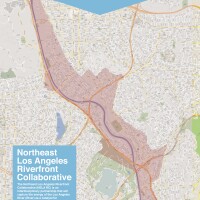Goal 6: Improve Governmental Regulation and Coordination of the River

The Riverfront is dynamic, requiring constant attention and oversight. Many governmental entities, each with a different purpose, have jurisdiction over the Riverfront. The complex regulatory process for construction along the River makes it difficult for spaces to be improved.
To enhance the riverfront with the parks, housing, commercial, and recreational activity envisioned in this plan, clearer procedures and enhanced coordination at all levels of government is essential.
There are multiple entities with jurisdiction over various aspects of the River, requiring any management structure to be both comprehensive, yet flexible, to allow entities to work in collaboration and independently when necessary. A basic overview of the jurisdictional divisions can be divided into the River channel and its corridor.
The River channel includes the riverbed and its concrete lining, maintenance access paths, fencing, and bridge piers. In simplified terms, the River channel area is governed by three agencies, with the following jurisdictional authorities:
- United States Army Corps of Engineers (Corps) governs flood protection regulations and standards; water releases from the dams; and maintenance of channel sections under Federal ownership.
- Los Angeles County Department of Public Works (County) governs maintenance of channel sections under County ownership, mostly storm drain outlets and permits for channel modifications.=
- City of Los Angeles (City) governs some storm drain outlets, water releases from treatment plants, and use of water within the channel.
The River corridor includes the adjoining neighborhoods, roads, bridges, and landscaping - governing by the full range of City agencies. Much of the land beyond the River is in private ownership and regulated by zoning and City standards.
Jurisdiction over operation, maintenance, and modifications of the River extends to the limits of the rights-of-way, whether they are owned in fee title or held by easement. The following objectives help facilitate a clear process for managing and growing the River channel and its corridor.

ObjectivesA. Environmental permits are required for a wide assortment of projects that involve building in or on the Riverfront. Obtaining permits in a timely, transparent manner, will encourage property improvements, especially new housing, businesses, or open spaces. Similarly, improving the permitting process for water-related construction is critical to ensure that River projects can move forward.
Overall, the permitting process should foster outcomes that protect and enhance the environment, as well as promote cultural and economic development on the River. Several approaches could be pursued to help applicants. A one-stop shop for permit applications could be established to provide applicants with a central information repository with application materials and project guidance.
B. By providing incentives for local, regional, state, and federal cooperation, meaningful intergovernmental partnerships can effectively respond to future challenges and opportunities in community and economic development. This objective is critical because disinvestment and deterioration of core areas along the Riverfront affect the vitality of its adjacent communities
Specifically, issues of regional significance require regional coordination. Several initiatives discussed in this document, such as Greenway 2020, will necessitate coordination among numerous governments within the region. The financial needs to for many projects will require funding sources from a range of public and private entities, further requiring regional collaboration.
C. The long and often complex process to approve a variety of River-related projects has highlighted the need for a stronger management structure and point positions in certain agencies. With the City's recent restructuring, the dissolution of the Community Redevelopment Agency and the creation of a new Economic Workforce Development Department, the implementation of many of recommendations in this plan will require a coordinating entity.
Furthermore, the success of this plan will also require funding from both public and private sources. As the only Sustainable Communities grant in Los Angeles, the recommendations in this plan are well positioned for various sources of public funding. The development of a job position, whether a new position or folded into an existing position, can help coordinate both the funding and implementation of these recommendations.


